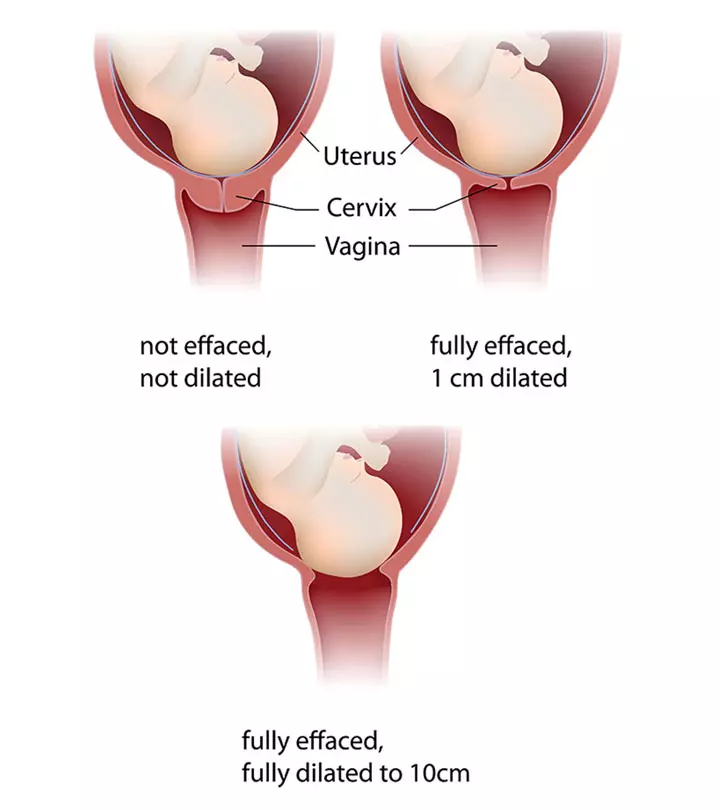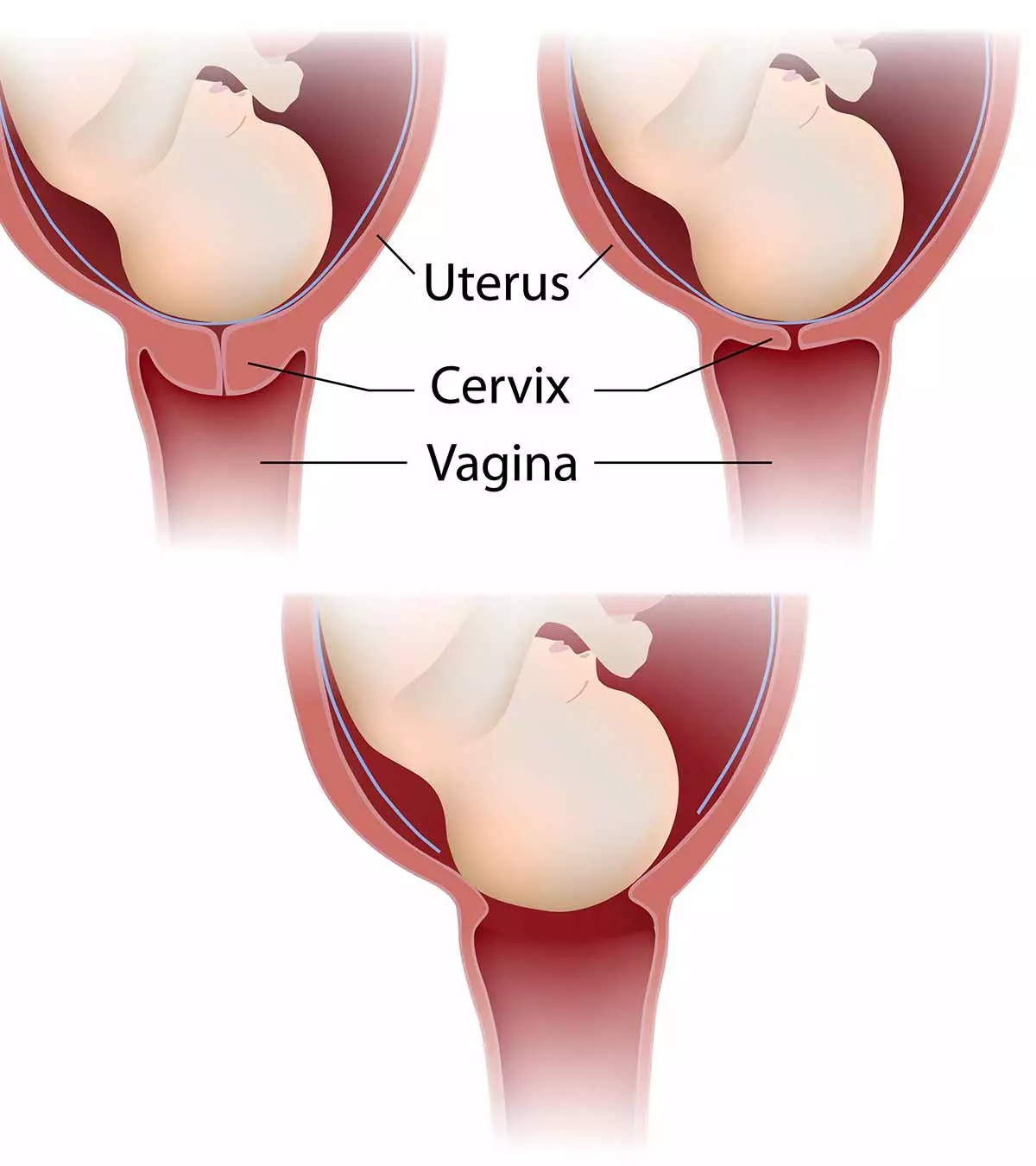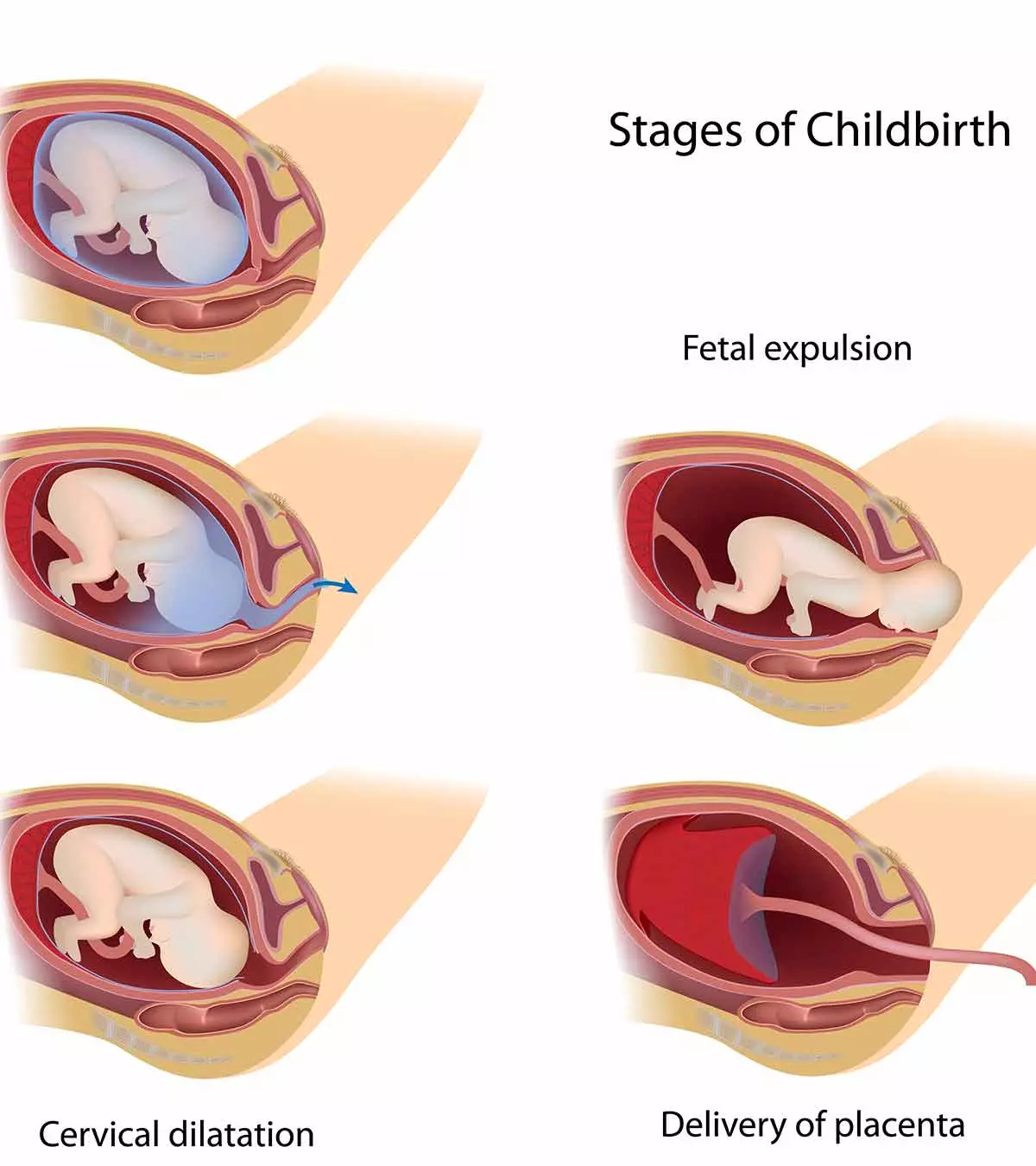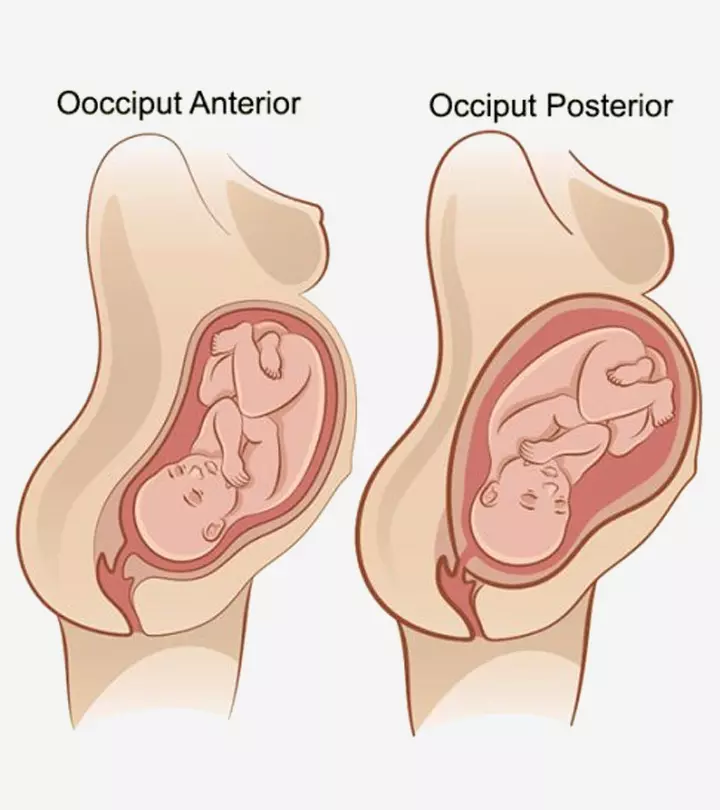
Image: Shutterstock
Normal delivery is the natural way of birth and is generally safer for the mother and the baby. However, some mothers opt for a C-section because they get anxious about labor pain. Research highlights that 85% of pregnant women can have a normal delivery, and only 15% may need a C-section due to medical reasons. However, statistics show that more than 30% of pregnant women undergo a C-section, suggesting that elective cesarean delivery has become prevalent (1). The Centers for Disease Control and Prevention released data on the surge in cesarean delivery rates in the US during 2025. The rate witnessed a marginal increase from 31.8% in the preceding year to 32.1%, indicating a concerning trend (2). While a C-section looks like an easier choice, it requires an extended recovery period and could pose complications during and after delivery. Hence, a suitable delivery option should be chosen only after contemplating the pros and cons. Read on to learn some tips that may help raise your chances of normal delivery and some ways to help ensure you go through the labor process smoothly.

Key Pointers
- The chance of having a vaginal birth increases with a smooth pregnancy and good health of the mother throughout the pregnancy.
- Choosing the right doctor, staying hydrated, avoiding stress, and receiving chiropractic therapy during pregnancy may increase the likelihood of a normal birth.
- Incorporating walking, swimming, and yoga can help keep pregnant women active and promote vaginal birth.
- Normal childbirth offers advantages such as quick healing, short hospital stays, no major surgery, and simple breastfeeding.
What Is Normal Delivery?
Normal delivery is a natural way of bringing the baby into this world. It is not difficult to have natural and normal childbirth unless you have some medical conditions. Moreover, the natural birth process helps in having a healthy baby and speedy recovery for the new mom (3).
Though there is no formula or shortcut to have a normal delivery, some measures can improve your chances of having a healthy and natural delivery.
What Factors Improve Your Chances Of A Normal Delivery?

Certain factors determine your ability to have a normal delivery. They may not guarantee a 100% result, though. You may have increased chances of a normal delivery if:
- You had a normal vaginal delivery in your previous pregnancies.
- You do not have any underlying health issues, such as asthma, which may aggravate during pregnancy and labor.
- You have an ideal weight, as being overweight could increase the chances of having a large baby and lower the chances of normal delivery.
- Your pregnancy is going smoothly without any complications.
- You are physically active throughout your pregnancy. The more physically fit you are, the higher are the chances of normal birth.
- Your physiological conditions, including blood pressure, blood sugar, and hemoglobin, are in control (4).
The above are the general health factors during pregnancy that influence your chances of having a normal delivery. You could also follow a few tips that could help increase the chances of normal delivery for you.
Tips For Normal Delivery
Normal vaginal delivery is the best way to give birth, both for the mother and child. And if you are hoping to go natural, you may follow these tips for a natural birth without interventions (5):
1. Stay away from stress:
It is common to feel stressed during pregnancy. It is advisable to avoid stress, anxiety, and random thoughts because negative emotions can turn the process of childbirth into a nightmare. Studies indicate that stress during pregnancy may contribute to early labor, raising the likelihood of a C-section delivery (6).
- Try any form of meditation that helps you feel comfortable.
- Read books, listen to music, and involve in visualization techniques.
- Remain in the company of good and friendly people.
- Stay away from people and situations that make you feel uncomfortable or negative.
2. Stay positive and refrain from negative birth stories:
You may come across both easy and difficult childbirth stories. Listening to negative stories would make you more anxious and may result in a panic attack.
- If a fellow mother happens to share her bad experience of childbirth, just walk away from her.
- Say no to gossip.
- Remember that not everyone has the same story of labor. Just because your friend had an unfortunate delivery does not mean you will have one.
3. Acquire knowledge about birthing:

Knowledge is power. Acquire as much knowledge as possible about labor and the delivery process.
- Get all your doubts about pregnancy and childbirth cleared by your doctor.
- Read books about childbirth.
- Talk to your mother or other older women in the family who can help you with their experience.
- Grab information on natural management techniques such as relaxation, breathing, and coping techniques.
- Enroll in antenataliPreventive healthcare before birth or during pregnancy classes.
However, do not be overwhelmed. Sometimes, too much information can also be a problem. When the time is right, the medical professional will help you get through the situation.
4. Build a strong support system:
Have enough emotional support. Have your partner, mother, and close friends around so that they are there to boost your confidence and allay your fears about normal delivery (7).
- Make sure you and your partner are on the same page when it comes to childbirth.
- Your family will stand by your side, but if you have any different views or ideas about pregnancy, do share them with them and come to a consensus.
- Having a support system can help take away the stress.
5. Choose your doctor wisely:
It is a sad fact that many doctors look for convenience and convince mothers to have a C-section. So, it is important to choose a doctor who will manage your pregnancy appropriately.
- Make sure your doctor and the clinic have a good rate of normal delivery.
- Talk to your doctor about their views on normal delivery.
- If you feel that your doctor may not respect your wish of having a normal delivery, look for another doctor.
6. Hire an experienced doula:
If you can find an experienced doulaiA professional labor assistant who provides physical and emotional support to the mother, partner, and family to help with your childbirth, that’s half the battle won!
- An experienced doula can be invaluable during labor and delivery.
- She can help you stay calm and be your advocate during labor.
- Post-birth, she helps you breastfeed the baby.
7. Regular perineal massage can help your body get ready for normal delivery.
- You can start doing perineal massageiMassage aimed at stretching the perineal tissues ready for birth once you enter the seventh month.
- It helps you deal with labor and manage stress too.
- To massage the perineum, hook your thumb inside, and gently pull the lower part of the vagina outward and forward (8).
8. Stay hydrated:
Water is vital for your health, more so now that you are pregnant.
- Labor is hard for the body, and you’ll need extra water to stay hydrated. Your body gets a lot of stamina and energy with water, and you will be less likely to need intravenous fluids.
- You can also stock up on some fresh juices or healthy energy drinks to get your daily quota of fluids. This is one of the best tips to have a normal delivery.
9. Use water:
Apart from drinking water, you can also use it to make the labor process easier.
- HydrotherapyiA treatment method that uses water to treat a variety of symptoms can help beat stress and reduce discomfort and pain during labor.
- Fill the bathtub with water and soak in it for relief. Also, showers, birthing pools, and hot compresses could help ease pain and offer relaxation.
- Keep the water at room temperature to avoid any harm to your unborn baby.
10. Try the ice game:
If you want to know how best to cope with the birthing process, try the ice game that requires your partner’s participation too.
- Take turns to hold an ice cube in your hand for 60 seconds.
- The first time around, you can try holding the ice cube while talking to each other.
- Next, try holding the ice cube while walking around.
- Finally, hold an ice cube in complete silence for 60 seconds.
- It is a great way to gauge how long you can take the pain and cope with labor pain.
11. Keep a watch on your postures:
Keep your body aligned so that the baby can glide smoothly. Standing and sitting for extended periods, sleeping in awkward positions, and wearing high heels and tight belts could misalign your body.
- Sit with proper support to your back. There would be added pressure on your spine during pregnancy, and mishandling your body can only increase the pain.
- Sit with folded or stretched out legs as hanging them for too long can lead to swelling.
- Do not slouch when sitting or bending to lift things. Do not rush down or up the stairs.
12. Try not to put on excess weight:
Yes, it is important to achieve a decent amount of weight during pregnancy, but you don’t need to pile on the pounds. Overweight women can have problems during labor and may end up with a C-section.
- Obesity can make it difficult to monitor the baby during labor, making normal delivery difficult.
- If you are obese, your baby could be big, making it difficult for the baby to come out (9).
13. Go for chiropractic adjustments:
Some people believe in chiropractic adjustments; some don’t. But you can give it a try and continue if you see good results with regular visits to a chiropractor.
- Chiropractic adjustments can help relieve stress.
- A good practitioner can provide relief from tense and painful muscles as well as pinched nerves.
- You can also get relief from back pain and strengthen your thighs and back with regular adjustments. It can be a big help during normal delivery.
- Chiropractic adjustments help fix an out-of-line pelvis and assist in normal delivery.
- You can see a chiropractor once a month in the first and second trimesters, and more often in the final trimester (10).
Food Tips For Normal Delivery
Your diet plays an important role in keeping you healthy, thus paving the way for a natural birth.
1. Eat right:

A healthy mother means a healthy baby.
- Your diet should consist of a healthy dose of fruits, vegetables, lean meat, legumes, and dairy.
- Choose dark green vegetables, a good amount of starchy food, and foods that are rich in protein.
- Your body needs extra iron during pregnancy, so make sure you eat an iron-rich diet.
- Avoid organ meat.
- Avoid foods that contain retinol.
- Consume seafood in moderate amounts.
- Reduce your intake of sugar.
- Avoid eating street food as they may contain bacteria, which could harm your health (11).
2. Include bromelain-rich foods:
BromelainiA type of enzyme found in the stem, fruit, and juice of pineapples is an enzyme that can stimulate labor and soften the cervix. Research suggests that regularly eating pineapple can help prepare the cervix for labor and may contribute to its onset, without causing any adverse effects on the mother or fetus (12).
- Fruits, such as mango and pineapple, are rich in bromelain.
- Consume raw bromelain-rich food for the best results.
- But do not consume these fruits in excess as you may go into premature labor (13).
3. Eat spicy food:
It may be an old wife’s tale, but many women swear by this trick (14)!
- Spicy food can make your body warmer and encourage normal delivery.
- But some women may end up with a bad case of indigestion, heartburn, and diarrhea due to spicy foods. If that is the case with you, avoid this and try something else!
 Did you know?
Did you know?A little bit of exercise never hurts anyone. Keeping yourself physically active during pregnancy aids in normal delivery.
Pregnancy Exercises For Normal Delivery
The American College of Obstetricians and Gynecologists states that research suggests pregnant women who stay physically active may have a lower chance of developing gestational diabetesihigh blood sugar that occurs during pregnancy and usually resolves after delivery , require fewer cesarean or assisted vaginal deliveries, and recover more quickly after childbirth (15). Do not begin any exercise without informing your doctor. Your doctor is the best person to know the effective exercises for a normal delivery that would suit your body best. Here are some normal delivery exercises that help your baby reach an optimal birthing position and strengthen your pelvic floor (16):
1. Practice right breathing exercises:
Breathing is something you don’t even notice. But it is the one thing that can make the whole labor process easier, negating the need for a C-section.
Here are some breathing exercises for normal delivery:
- Breathing from the chest
- Breathing from the stomach
- Shallow breathing
- Alternate deep and shallow breathing
2. Walking and swimming:

Both are highly recommended exercises for pregnant women.
- Walking is an excellent low-intensity exercise. So, grab a pair of good shoes and start walking. You can walk around the house or in your garden for at least 30 minutes twice a day. It helps prevent constipation, high blood pressure, and restlessness and is also one of the safest and most effective exercises to induce labor naturally.
- Swimming is another great way to stay fit and be ready for normal delivery. It prevents muscle injury, regulates heartbeat, strengthens your muscles, and keeps your body fit.
3. Regular exercises:
Indulging in mild exercises will not only build your stamina but also keep you active during pregnancy. Some exercises you can try are:
- KegelsiExercises to strengthen the pelvic floor muscles which support the uterus, bladder, small intestine, and rectum, also known as pelvic floor exercises that make the thigh muscles stronger and help in beating the stress during labor pain.
- Pelvic tilts, and cat and cow stretches that loosen the pelvic muscles and make the lower back flexible.
- Butterfly pose opens the pelvis and stretches the lower back.
- Squatting helps to open the pelvis and get your baby into the best birthing position.
4. Prenatal yoga:
Yoga is not just a great way to a healthier body, but also a means to ease out your delivery.
- Yoga is all about breathing right, which can be of great help during labor and delivery.
- Some yoga poses are perfect for pregnancy as they help relieve lower back tension.
- These poses help to open up your chest, shoulders, and hips.
- Take antenatal yoga classes from a specialist so that it is safe for you and your baby (17).
If these tips improve the chances of vaginal delivery, your body may send some signals that it is ready for a natural birth, as the due date approaches. Read on to know what they are.
Signs And Symptoms Of Normal Delivery
Changes may occur a few weeks before the expected due date. And your doctor asks you to be on the lookout for these signs as they indicate labor. However, the signs and symptoms may vary from one woman to another, and from pregnancy to pregnancy.
Pre-labor signs and symptoms that appear one to four weeks before labor:
- Lack of coordination in movements as the baby descends lower into the pelvic region
- Loosened joints, as relaxin hormone softens and relaxes the ligaments and joints in the pelvic area
- Urge to urinate frequently as the baby’s head presses against the urinary bladder
- Braxton Hicks contractions, the false contractions that develop before the real labor
- Cramping and pain in the lower back as the joints and muscles stretch and become active for the nearing labor
- Dilation of the cervix, which is noted by your doctor during the antenatal checkup
- Watery stools as the rectal muscles begin to relax for the delivery (18).
Early labor signs and symptoms that appear days or hours before labor:
- Vaginal discharge increases and becomes thicker
- Parts of mucus plug get eliminated every time you urinate; look for pinkish and thick mucus as this is an important sign of nearing labor also called “show”.
- More frequent and stronger contractions that progress with time
- Cramping and pain in the lower back that radiates to abdomen and legs
- Water breaking, i.e., the rupture of the amniotic sac (19).
Once you observe these signs, make sure to have your partner or any other person near you to monitor your condition.
Advanced Labor Signs And Symptoms
- Warm sensation in the abdomen
- Increasing contractions
- Severe pains from contractions that continue for almost 40 to 60 seconds
- Intensifying back pain
- Vaginal bleeding
- While some women go straight into advanced labor, some others may undergo all of this discomfort associated with normal delivery (20).
So, why are we emphasizing natural birth all along? Find out next.
Why Should You Prefer Normal Delivery?
The answer is simple: Birthing is a natural process, and the human body is designed to go through an unmedicated birth, also known as a physiological birth. Leave alone a C-section; healthy women may not even require painkillers or epiduralsiA shot administered in the back to numb a specific area of the body and block pain sensations . Unfortunately, some health practitioners may assume that laboring women would need pain medications, or simply recommend a C-section to avoid pain (21). According to studies, 45% of women who had a cesarean delivery for their first birth expressed a preference for a vaginal delivery for their next childbirth at 12 months postpartum (22). Kimberly Langdon, MD, an obstetrician and gynecologist, says, “Spontaneous vaginal birth, also known as normal vaginal delivery, is the safest method of delivery for both mother and baby. With a vaginal delivery, the mother has a better chance of successfully breastfeeding after childbirth, a shorter hospital stay, a faster physical and psychological recovery, and a stronger mother-child bond. Vaginal delivery also benefits the baby by improving respiratory function, temperature regulation, and the development of a stronger immune system.”
But we will tell you why you should keep your delivery as natural as possible.
1. Healthier for both mom and baby:
Vaginal birth is a low-intervention childbirth technique that takes shorter recovery time. Babies receive protective bacteria from the birth canal, which helps build their immune system. Passing through the birth canal may also expel excess amniotic fluid from the lungs lowering the risk of respiratory diseases. In the case of a cesarean delivery, the resultant contractions followed by uterine stimulants (such as Pitocin drip), will become so fast and strong that you will not have enough recovery time. This passes less oxygen to the fetus. Also, epidurals could increase the likeliness of fever, forcing you to take antibiotics (23) (24).
2. Facilitates breastfeeding:
Babies delivered naturally adapt to breastfeeding with ease. The pain relievers given in C-section deliveries pass on to the baby through breastfeeding. Therefore, the baby shows abnormal suckling behavior shortly after birth (25). Also, the baby has difficulty latching and could show uncoordinated suck/swallow response for some hours or days.
3. Greater connection with the body:
You will stay alert and conscious of the nearing labor when drugs are not used. You will be connected to your body. Pain medications usually diminish a woman’s sense of being physically attached to the birthing process.
4. Faster post-delivery recovery:
Natural delivery, being a non-surgical birth technique, is always followed by a short recovery period as it does not involve any numbing medications, needles, or tubes over the body parts. You can walk around and indulge in physical activity without affecting your health. During natural birth, the body produces pain-relieving and calming hormones or endorphins. But, if pain medication is used, the body will not produce as many endorphins (23).
5. Makes you feel confident:
Women who give natural birth feel more confident and empowered. It could make you feel stronger and less fearful about accepting other challenges that come in life (26).
6. Short hospital stay:
Labor can be painful and exhausting, but once you are done, you are done! One of the most significant benefits of vaginal birth is that it entails a shorter hospital stay and recovery time when compared to a C-section.
7. No major surgery:
A C-section is major surgery. So, if you can have a vaginal birth, you’ll not only escape going under the knife but also not have the numerous health risks associated with it, including severe bleeding, scarring, infections, reactions to anesthesia, and pain.
8. Quicker bonding:

Skin to skin exposure is a great way to bond with a newborn. With normal delivery, it is easier for the mother to hold her baby and have a bond quickly.
9. Lower chances of lung problems:
The muscles working to push the baby out during a normal delivery can also squeeze out fluid from the baby’s lungs. That is why babies born via normal delivery are less likely to suffer from breathing difficulties (27).
10. A boost to the baby’s immune system:
Did you know that a normal delivery can be a boon for your baby’s immune system? Well, a baby gets a dose of good bacteria when it is traveling through the birth canal. This strengthens the baby’s immune and digestive systems (28).
After knowing about the goodness of natural birth, you must be wondering how our body can manage to go through this intricate process. Well, we will explain it next.
What Is The Process Of A Normal Delivery?
Normal childbirth is divided into three stages.
Stage 1: It consists of three phases – latent, active, and transition – where the cervix effaces and dilates.
I. Early Or Latent Phase: Cervix Dilates From 0-4cm
This initial step lasts from six to ten hours in first-time pregnancies. In some cases, it can be longer or shorter.
What Will You Experience?
- The cervix thins out and opens up to 3-4cm.
- Contractions become frequent, occur irregularly between five and 30 minutes, and last for 30 to 45 seconds.
- Abdominal discomfort is followed by a slightly pink discharge. This is the time you may be admitted to the hospital and frequently checked for the degree of dilation (29).
What Can Help?
- Rest and take good care of yourself.
- Alternate between activity and rest (for instance, take a short walk followed by a shower), drink plenty of fluids and eat easily digestible foods.
- The best place to stay is at home (or hospital). Do not move around a lot.
- Have someone with you so that you can stay calm and be confident that you are not alone.
- When contractions become stronger, you can do relaxation and breathing exercises.
- Get a shoulder massage from your partner or listen to music for a pleasant environment.
II. Active Phase: Cervix Dilates From 4-7cm
This phase lasts from three to six hours in first-time pregnancy and for a lesser duration in the subsequent deliveries.
What Will You Experience?
- With each contraction, you will feel severe pain and pressure in the abdomen and back.
- The contractions now occur between three and five minutes and radiate along the lower back, abdomen, and thighs.
- You will feel the urge to push down and become more focused. You might have dark pink or brown discharge (30).
What Can Help?
- Empty your bladder and have a lot of fluids.
- Try to do relaxation or breathing exercises and take rest between contractions.
- Change positions often to stay comfortable and support progression.
- As the contractions get stronger, you could ask your partner to give you a massage.
- Take a warm shower if your healthcare practitioner allows you to do so.
- You can also make the environment pleasant by dimming the lights and playing light music.
III. Transition Phase: Cervix Dilates To 10cm
This phase may last between 20 minutes and two hours in first-time pregnancy and for a lesser duration in subsequent pregnancies.
What Will You Experience?
- Cervix completes dilation and effacement.
- Contractions become strong, frequent, and painful and recur every three to four minutes.
- You will feel increasingly nauseous, fatigued, and shivery.
- You will have a strong urge to push down as there is pressure built in the rectal and vaginal area. But do not push until your doctor gives you the signal (30).
What Can Help?
- Focus on breathing and relaxation techniques.
- If you have a strong urge to push, but it is not the right time yet, your practitioner will tell you about the ways to resist the urge.
- Your partner should encourage you and give you undivided attention.
Stage 2: The baby is pushed out and delivered.
This stage begins with a fully dilated cervix. It lasts between half-an-hour and two hours in first-time pregnancies and reduces in subsequent births.
What Will You Experience?
- The body transits from dilating to pushing.
- The baby makes her way down through the pelvic region and birth canal.
- The soft spots on the baby’s head, called fontanels, allow the body to fit through the birth canal.
- Just before the baby pushes out, you will feel a stinging, burning, and stretching sensation near the vaginal opening.
- The baby’s head comes out first, and then you will find it easier to push the rest of the body out.
- Your practitioner will clamp and cut the umbilical cord.
What Can Help?
- Just breathe easy and look at your partner or family member as they would encourage you.
- If the labor is progressing slowly, try to change positions. All-fours, side-lying, and squatting can help you.
- You may feel the tension in the perineum. Warm compresses relieve the tension.
- Your practitioner will tell you the right way to breathe and push. Follow their instructions.
Stage 3: The placenta is removed from the body.
It is also called “the afterbirth,” which happens right after the birth of the baby. It usually takes about a few minutes to half-an-hour.
What Will You Experience?
- The cord is cut, and your baby is cleaned and placed on the abdomen.
- You will be asked to push out the placenta when again, you will have pain and cramping (31).
- You could be so overwhelmed with your baby in your arms that you may not even notice this phase.
What Can Help?
- Place your baby on your breast for skin-to-skin contact. Touch, cuddle and caress them.
- It is time to breastfeed the baby for the first time, and this helps tighten the uterus and decrease bleeding.
- Apply a cold compress to the perineum as it helps reduce swelling and eases the discomfort.
No matter how long the labor lasts, seeing the baby’s face and holding them makes it all worth the effort. But if you want to have a general idea about the duration of normal delivery, read on.
A mother of three shares her experience of birthing her first child, she says, “I was already three days overdue, and the doctor induced the labor at six in the morning. I went back to my room and walked around with my husband in the hospital corridors; bouts of pain were coming here and there, and by 12 noon, I was in great pain. They put me in the hospital gown and admitted me into the preparation room. I was convinced the baby will arrive soon. The doctor came and checked and said, “Great, your labor is starting!” I lay there stunned. Starting!. At four in the evening, the nurse cut the sac, letting out the amniotic fluid to speed up the labor. By around five in the evening, when I was convinced there couldn’t be any pain worse than this, I heard myself screaming like never before in my life.
“Then the pain changed; it wasn’t any less, but there was this new feeling of wanting to push. I don’t know how else to explain that feeling. It’s a real sense of the baby ready to come out. It sort of distracts you from the severe pain of contractions. I was quickly rushed to the labor room, made to lie on a funny contraption in a position convenient for the doctor to catch the baby. This time, somehow, you welcome the wave of contractions, and with each contraction, everyone in the labor room, including doctors, nurses, and other helping ayahs, would scream “Push!” and I would push with all my might. Then the crowning happened! The doctor saw the baby’s head, and he said, ‘That’s a huge baby.’ He made the episiotomy cut a little wider so that I wouldn’t tear when the baby came out. Imagine that I wasn’t even aware of the pain in such a delicate part of my anatomy being sliced open with a surgical knife. It’s like stubbing your toe while breaking your leg, the smaller pain just doesn’t register. With the next and final push with everyone in the room yelling, my gorgeous son Rohaan entered into our world at five thirty-nine in the evening (i).”
 Did you know?
Did you know?How Long Does Normal Delivery Last?
A normal delivery usually takes about 12 to 14 hours. This is in the case of first delivery, and the process gets shorter for subsequent deliveries (32).
However, the length and intensity of delivery change according to the below factors:
- The number of deliveries so far: The cervix tends to dilate quickly in subsequent deliveries.
- Prior experience: You may be more confident about this pregnancy as you have experienced pregnancy before.
- Strength and intensity of pains and contractions: Your body adapts to the force of contractions
- Ease of cervical dilation: As the vagina and pelvic floor muscles have already been stretched before, the cervix dilates easily.
- Baby’s position: If the baby is in a head-down position (anterior position), your labor is likely to be more relaxed and shorter.
- Calm and relaxed mind: It helps you get through the delivery easily as you muster mental strength.
Frequently Asked Questions
1. Can I tell my baby’s position based on his movements?
Though ultrasound scan is an accurate method to know the baby’s position, you can get some clues about which side your baby is lying, based on the movements.
Babies lying with their head down (cephalic position) will kick more strongly towards the top of the bump. Later in the pregnancy, you will feel like something is sticking out on both sides of your bump as babies stretch their legs quite often. Babies with their feet at the bottom (breech position) will kick in the lower part of the bump (33).
Your practitioner can tell you about the exact position of your baby during your routine antenatal checkups. If the baby is in a breech position, you may be asked to follow some natural methods to turn the baby into the right birthing position. In some cases, you may have to undergo a procedure called an external cephalic version (ECV), where the obstetrician will try turning the baby from outside the bump (34).
2. What is the first hospital admission like?
Once it is determined you are in labor, it is the time for you to be hospitalized. There would be forms to sign and paperwork to be done, which your partner can help you with.
Preliminary examinations will be conducted either by your practitioner or midwife. Based on the contraction patterns and fetal heart rates, there could be more procedures. The initial examination, however, involves cervical measurements – the dilation, effacement, and station (35).
3. How will you know when to push?
You will be encouraged to push once your cervix reaches a dilation of ten centimeters. For most women, pushing happens instinctively as they feel better when pushing, and get a burst of energy. For an effective push, you should take a deep breath and hold it in the lungs and bend forward so that your chin and legs are towards your chest. It could take anywhere from a few minutes to hours to push your baby out.
4. How painful is normal delivery?
Labor is a painful and intense process. The contracting uterus that pushes the baby out leads to muscle tightening in the abdominal region. It, therefore, exerts pressure on the back, vaginal area, rectal area, perineum, bladder, pelvic bolt, and abdomen. All these can result in intense pain and discomfort that will last until you deliver the baby (36).
5. What are the risks of having a vaginal delivery?
Dr. Langdon observes, “Excessive bleeding and infection are the most common maternal complications during and after childbirth, for both vaginal and cesarean deliveries. A collaborative effort between the patient and the medical team is required for a successful vaginal delivery to minimize and avoid complications.”
6. What are reasons to avoid vaginal delivery?
“High-risk pregnancies (underlying maternal medical conditions), advanced maternal age, fetal abnormalities, multiple pregnancies (triplets, quintuplets), and other factors may make vaginal delivery unsafe for an expectant mother. In fact, women over the age of 40 are more than twice as likely to have a cesarean section,” opines Dr. Langdon.
7. When should I start exercising for a normal delivery?
The right time to exercise depends on your fitness level and overall health. If you exercised before pregnancy, you may continue doing the same. However, if you are starting exercising during pregnancy, you may begin with moderate-intensity exercises, such as brisk walking. You may also do strengthening exercises, such as squatting, to strengthen your pelvic floor muscles. Nonetheless, it is advisable to speak to your healthcare provider to devise a suitable exercise regimen for you based on your health.
8. Which week is best for normal delivery?
The best time to have a normal delivery is between 37 and 42 weeks of pregnancy. Babies born earlier than 37 weeks are considered preterm and may have health problems. However, being pregnant for 39 weeks gives your baby’s brain, liver, and lungs adequate time to grow, significantly reducing their chances of developing any health concerns (37). On the other hand, pregnancies extending beyond 42 weeks are referred to as post-term pregnancies, which may increase the risk of certain health problems.
9. Is it possible for me to deliver normally without exercising?
Exercise doesn’t guarantee normal delivery. However, regular physical activity can help you maintain good overall health. It can help increase muscle strength, endurance, and flexibility, which can help make labor and delivery process relatively easier to manage.
Normal delivery is usually a safe childbirth method for both mother and baby. Avoid being too stressed about the labor pain and discomfort associated with normal delivery since your doctor and family will help you deal with the process. Instead, you may focus on preparing yourself for the delivery and welcoming your little one. If you have any concerns, communicate them to your healthcare provider. Additionally, try to follow the tips mentioned above, eat right, and practice safe exercises to increase your chances of natural birth. You can also enquire your midwife or doctor about gentle birth or calm birth techniques and have a maternal birth plan ready.
Infographic: Popular Myths And Facts About Normal Deliveries
Vaginal birth or normal delivery is the best choice for childbirth if there are no indications to undergo a cesarean section. You may begin breastfeeding immediately after childbirth, and recovery is faster in vaginal births. Go through the popular myths and facts about normal deliveries that may help decision-making.
Some thing wrong with infographic shortcode. please verify shortcode syntax
Get ready to sweat with this 30-minute pregnancy workout! Learn exercises and stretches to help you prepare for a normal delivery. Get fit and stay healthy during your pregnancy!
Personal Experience: Source
MomJunction articles include first-hand experiences to provide you with better insights through real-life narratives. Here are the sources of personal accounts referenced in this article.
i. My Childbirth Experiences – Normal delivery;https://anjumobin.blogspot.com/2012/04/my-delivery-experience-miracle-of-birth.html
References
- Sinéad M O’Neill, et al.; Caesarean delivery and subsequent pregnancy interval: a systematic review and meta-analysis
- Osterman, Michelle J. K., et al.; Births: Final Data for 2025.; National Vital Statistics Reports
- Ione Brunt; Normal Birth; Oregon Health Science University
- Judith A. Lothian; Safe, Healthy Birth: What Every Pregnant Woman Needs to Know
- How Can I Best Prepare for Pregnancy and Childbirth? The University of Minnesota
- Lilliecreutz, Caroline, et al.; Effect of Maternal Stress During Pregnancy on the Risk for Preterm Birth
- Pregnancy and Substance Use: A Harm Reduction Toolkit; National Harm Reduction Coalition
- Georgina Stamp; Perineal massage in labour and prevention of perineal trauma: randomised controlled trial
- Pregnancy and birth: Weight gain in pregnancy; Institute for Quality and Efficiency in Health Care; Cologne, Germany
- Cara L. Borggren; Pregnancy and chiropractic: a narrative review of the literature
- Food and pregnancy; The Ministry for Primary Industries
- Moghani, Sedigheh Shariat, et al.; Investigating the Effect of Edible Pineapple on the Ripening of the Cervix and the Onset of Labor
- Elaine Duryea; The truth about “natural” ways to induce labor
- Chaudhry Z, et al.; Women’s use of nonprescribed methods to induce labor: a brief report.
- Physical Activity and Exercise During Pregnancy and the Postpartum Period; American College of Obstetricians and Gynecologists
- Poyatos-León R, et al.; Effects of exercise during pregnancy on mode of delivery: a meta-analysis.
- Amy M. Romano and Henci Goer; Research Summaries for Normal Birth
- Giving birth – early signs of labour; Pregnancy, Birth and Baby
- Signs of Labor; American Pregnancy Association
- When does labor usually start?; The United States Department of Health & Human Services
- Mary McCauley, et al.; A survey of healthcare providers’ knowledge and attitudes regarding pain relief in labor for women in Ethiopia
- Attanasio, Laura B., et al.; Women’s Preference for Vaginal Birth After a First Delivery by Cesarean
- Vaginal Delivery; Cleveland Clinic
- Patel, Selina, et al.; Epidural-related Maternal Fever: Incidence, Pathophysiology, Outcomes, and Management
- Breastfeeding After Cesarean (C-Section) Delivery; American Academy of Pediatrics
- Judith A. Lothian; Why Natural Childbirth?
- Transient Tachypnea of the Newborn (TTN); Nemours KidsHealth
- Josef Neu and Jona Rushing; Cesarean versus Vaginal Delivery: Long term infant outcomes and the Hygiene Hypothesis
- Intrapartum Care: Care of Healthy Women and Their Babies During Childbirth.; National Collaborating Centre for Women’s and Children’s Health (UK); NICE Clinical Guidelines, No. 190.
- Normal birth; Queensland Maternity and Neonatal Clinical Guidelines Program
- Labour and Delivery Care Module: 5. Conducting a Normal Delivery; OpenLearn Create; The Open University
- Pregnancy – Labor; Cedars-Sinai Medical Center
- Kean LH, et al.; A comparison of fetal behaviour in breech and cephalic presentations at term.
- Hofmeyr GJ, et al.; External cephalic version for breech presentation at term.
- Lamberti G.; [Cervical ripeness. I. The clinical criteria of assessment of ripeness and their variability at term].
- Nastaran Mohammad Ali Beigi, et al.; Women’s experience of pain during childbirth
- Why at least 39 weeks is best for your baby; March of Dimes
- Andrea L DeMaria, et al.; (2018); Castor oil as a natural alternative to labor induction: A retrospective descriptive study; National Library of Medicine
- 5 Best Yoga Poses for Pregnant Women; Healthy Women
- 5 exercises and techniques to train for childbirth; The University of Texas Southwestern Medical Center
- Delayed Umbilical Cord Clamping After Birth; The American College of Obstetricians and Gynecologists
Community Experiences
Join the conversation and become a part of our nurturing community! Share your stories, experiences, and insights to connect with fellow parents.
Read full bio of Dr. Saurabh Phadnis
- Dr. Kimberly Langdon is a gynecologist with 19 years of experience wherein she delivered more than 2,000 babies. She is currently working as vice-president, product development and research at Physician Integrative Laboratories in the US. She did her doctor of medicine from the Ohio State University.
 Dr. Kimberly Langdon is a gynecologist with 19 years of experience wherein she delivered more than 2,000 babies. She is currently working as vice-president, product development and research at Physician Integrative Laboratories in the US. She did her doctor of medicine from the Ohio State University.
Dr. Kimberly Langdon is a gynecologist with 19 years of experience wherein she delivered more than 2,000 babies. She is currently working as vice-president, product development and research at Physician Integrative Laboratories in the US. She did her doctor of medicine from the Ohio State University.
Read full bio of Rebecca Malachi
Read full bio of Swati Patwal
Read full bio of Reshmi Das

 Quick tip
Quick tip














